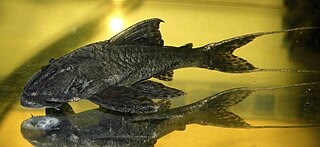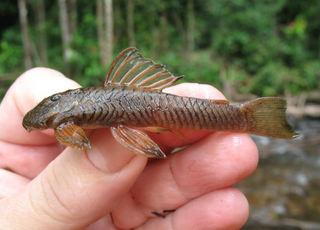
Catfish are a diverse group of ray-finned fish. Named for their prominent barbels, which resemble a cat's whiskers, catfish range in size and behavior from the three largest species alive, the Mekong giant catfish from Southeast Asia, the wels catfish of Eurasia, and the piraíba of South America, to detritivores, and even to a tiny parasitic species commonly called the candiru, Vandellia cirrhosa. Neither the armour-plated types nor the naked types have scales. Despite their name, not all catfish have prominent barbels or "whiskers". Members of the Siluriformes order are defined by features of the skull and swimbladder. Catfish are of considerable commercial importance; many of the larger species are farmed or fished for food. Many of the smaller species, particularly the genus Corydoras, are important in the aquarium hobby. Many catfish are nocturnal, but others are crepuscular or diurnal.

Cypriniformes is an order of ray-finned fish, including the carps, minnows, loaches, and relatives. This order contains 11-12, although some authorities have designated as many as 23, families over 400 genera, and more than 4,250 species, with new species being described every few months or so, and new genera being recognized frequently. They are most diverse in southeastern Asia, and are entirely absent from Australia and South America. At 112 years old, the longest-lived cypriniform fish documented is the bigmouth buffalo.

Callichthyidae is a family of catfishes, called armored catfishes due to the two rows of bony plates along the lengths of their bodies. It contains some of the most popular freshwater aquarium fish, such as many species in the genus Corydoras.

Hypostomus plecostomus, also known as the suckermouth catfish or the common pleco, is a tropical fish belonging to the armored catfish family (Loricariidae), named for the armor-like longitudinal rows of scutes that cover the upper parts of the head and body. Although the name Hypostomus plecostomus is often used to refer to common plecostomus sold in aquarium shops, most are actually members of other genera.

Loricariidae is the largest family of catfish, with 92 genera and just over 680 species. Loricariids originate from freshwater habitats of Costa Rica, Panama, and tropical and subtropical South America. These fish are noted for the bony plates covering their bodies and their suckermouths. Several genera are sold as "plecos", notably the suckermouth catfish, Hypostomus plecostomus, and are popular as aquarium fish.
Hypostomus punctatus, the suckermouthed catfish, is a tropical fish belonging to the armored suckermouth catfish family (Loricariidae). Hypostomus punctatus is a freshwater fish native to South America, in the coastal drainages of southeastern Brazil and Uruguay. It is one of a number of species commonly referred to as 'plecostomus' or 'common pleco' by aquarists.

Corydoras is a genus of freshwater catfish in the family Callichthyidae and subfamily Corydoradinae. The species usually have more restricted areas of endemism than other callichthyids, but the area of distribution of the entire genus almost equals the area of distribution of the family, except for Panama where Corydoras is not present. Corydoras species are distributed in South America where they can be found from the east of the Andes to the Atlantic coast, from Trinidad to the Río de la Plata drainage in northern Argentina. Species assigned to Corydoras display a broad diversity of body shapes and coloration. Corydoras are small fish, ranging from 2.5 to 12 cm in SL., and are protected from predators by their body armor and by their sharp, typically venomous spines.

The zebra oto or tiger oto is a fish of the genus Otocinclus of the family Loricariidae that originates from Peru.

Pseudorinelepis genibarbis is a species of armored catfish native to Brazil and Peru where it is found in the Amazon basin.

The Ariidae or ariid catfish are a family of catfish that mainly live in marine waters with many freshwater and brackish water species. They are found worldwide in tropical to warm temperate zones. The family includes about 143 species.

Pterygoplichthys or commonly known as Janitor fish is a genus of South American armored catfishes. These fish are commonly known as sailfin armoured catfish or sailfin plecs.

Catfish are easy to farm in warm climates, leading to inexpensive and safe food at local grocers. Catfish raised in inland tanks or channels are considered safe for the environment, since their waste and disease should be contained and not spread to the wild.

Hemiancistrus is a genus of suckermouth armored catfishes. These species are native to South America. The taxonomy of this genus is complex and unclear, and major work has to be done. Many of these fish are popular aquarium fish.
Corymbophanes is a genus of armored catfish native to South America where they are only known from Guyana. Corymbophanes was originally placed in its own tribe Corymbophanini, but the first comprehensive molecular phylogenetic analysis of the subfamily Hypostominae found Corymbophanes to be nested within the tribe Ancistrini.

Loricariinae is a subfamily of the family Loricariidae of catfish. This subfamily is divided into two tribes and about 30 genera. They are mainly native to freshwater habitats in South America, but there are also several species in Panama and a single (Fonchiiichthys) in Costa Rica.
Harttiella is a genus of armored catfishes native to South America.

Agamyxis pectinifrons, the spotted talking catfish, spotted raphael catfish or whitebarred catfish, is a species of thorny catfish found in the Amazon basin where it has been recorded from Bolivia, Brazil, Colombia and Peru. This species grows to a length of 15 centimetres (5.9 in) SL.

Ictalurus pricei, the Yaqui catfish, is a species of North American freshwater catfish native to Mexico and Arizona.

The yellowfin madtom is a species of fish in the family Ictaluridae endemic to the southeastern United States. Historically, the yellowfin madtom was widespread throughout the upper Tennessee River drainage, but was thought to be extinct by the time it was formally described.

Guyanancistrus nassauensis is a species of catfish belonging to the family Loricariidae, the suckermouth armored catfishes. It is discovered in 2005 and formally described in 2018. G. nassauensis is a rare species, highly endemic to the Nassau Mountains in Suriname, and is threatened with extinction by proposed or ongoing mining activities.















